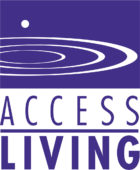Assisted Suicide and What It Means for People with Disabilities
Access Living has opposed assisted suicide since the 1980s due to its impact to people with disabilities. With pending legislation appearing in the Illinois General Assembly, our team is working hard to advocate for the rights and safety of people with disabilities.
What is Assisted Suicide?
Assisted suicide, also known as Medical Aid in Dying (MAID), is a prescription given by a doctor to a terminally ill patient to end their life. The term “Assisted Suicide” is used because a physician is writing the prescription (assisted) and the patient chooses to end their own life (suicide). Illinois’ proposed legislation, SB3499, would allow for an assortment of lethal pills taken by mouth. . Access Living is part of the Stop Assisted Suicide Illinois coalition, which opposes SB 3499.
Access Living Assisted Suicide Webinars and Videos
Why Does Access Living Oppose Assisted Suicide?
Access Living has been opposed to Assisted Suicide since the 1980s, as we have monitored proposed legislation, analyzed their potential impact on people with disabilities, and engaged in the national disability debate on the issue.
1. Impact on the healthcare experience of people with disabilities
Physician bias towards people with disabilities is significant. In a survey of 714 practicing physicians nationwide, 82.4% reported that people with significant disabilities have a worse quality of life than nondisabled people. This bias and lack of education on disability is reinforced by a 2019-2024 study as patient reported resilience measures showed life satisfaction was strongly correlated to meaning and purpose. Life satisfaction was not associated with clinician rated disability severity. Subtle to coercion by physicians to push for Assisted Suicide instead of other end-of-life options is a reality for people with disabilities. In a for-profit healthcare system, insurance providers may be willing to pay for the cheapest option (lethal prescription) instead of hospice. These biases increase significantly when race is factored alongside disability.
2. Impact on people with disabilities living in institutions or congregate care settings
As mentioned, physicians hold significant biases against people with disabilities. Those with disabilities in institutions and nursing homes face high rates of depression with about 30% of nursing home residents suffering from depression each year. These factors combined with internalized ableism leads to people with disabilities feeling like a burden or drain. Providing a “choice” of death rather than eliminating physician bias, improving the autonomy of individuals, and creating accessible and equitable hospice care is not providing a choice at all.
3. Impact on incarcerated people with disabilities
Wexford Health Solutions, the company Illinois picked to provide prison health care, has faced, and has been found responsible, for many lawsuits alleging abuse, neglect, and refusal to treat patients. Because of the “right to die” argument made by supporters, Assisted Suicide will be made available in Illinois prisons. Cases such as Dean v. Wexford, insignificant hospice care in Illinois prisons, and low amounts of releases via the Joe Coleman Act, all point to Assisted Suicide becoming a preferred option for Wexford Health Solutions.
Myths and Misconceptions About Assisted Suicide
- “Assisted suicide is a peaceful death.”
Because the prescription is taken by mouth, there is no guarantee of a peaceful transition for the patient. This medication takes time to be absorbed with time to death ranging from one minute to over four days. - “There are safeguards in place and only a small number of people will use assisted suicide to end their lives.”
Canada implemented assisted suicide with extensive regulations in place. Then a lawsuit eliminated many of these regulations and eligibility for assisted suicide expanded significantly. It has become a leading cause of death in Canada (4.1%). - “People who request assisted suicide usually do so because they are experiencing severe, intractable pain and suffering.”
Data from Oregon shows most requests are because of loss autonomy (97.2%), inability to engage in enjoyable activity (88.9%), and loss of dignity (75%) while inadequate pain control was the second to last reason (26.4%) - “Thorough mental health screenings to rule out depression are required for those requesting assisted suicide.”
Screenings are not required unless a physician requests one. - “Assisted suicide provides choices for a terminal patient.”
End of life control options already exist (DNRs, living wills, etc.). However, biases in the health care systems often lead to certain end of life options (such as assisted suicide) being encouraged over others.
Access Living Assisted Suicide Webinars and Videos
Assisted Suicide: What Does it Mean for People with Disabilities?
Access Living’s Sebastian Nalls and Ryan McGraw discuss the disability perspective on assisted suicide with special guests John Kelly and Pam Daly, from Second Thoughts MA.
Assisted Suicide and Communities of Color
Access Living’s Candace Coleman discusses assisted suicide with Not Dead Yet‘s Director of Minority Outreach, Anita Cameron, a legendary disability activist.
The History and Pitfalls of Assisted Suicide
Access Living’s Amber Smock interviews Anne Sommers McIntosh, the Executive Director of the National Council on Disability (NCD). NCD is the independent federal agency advising Congress and the White House on disability issues.
